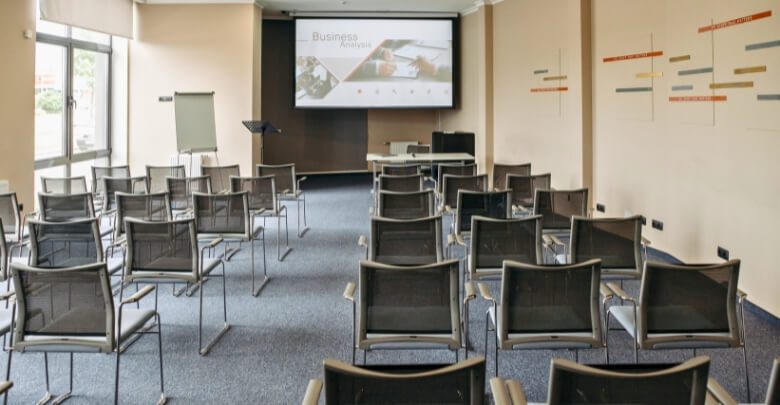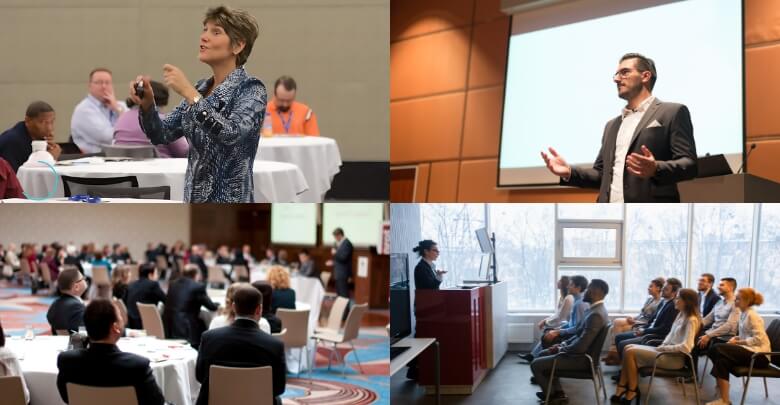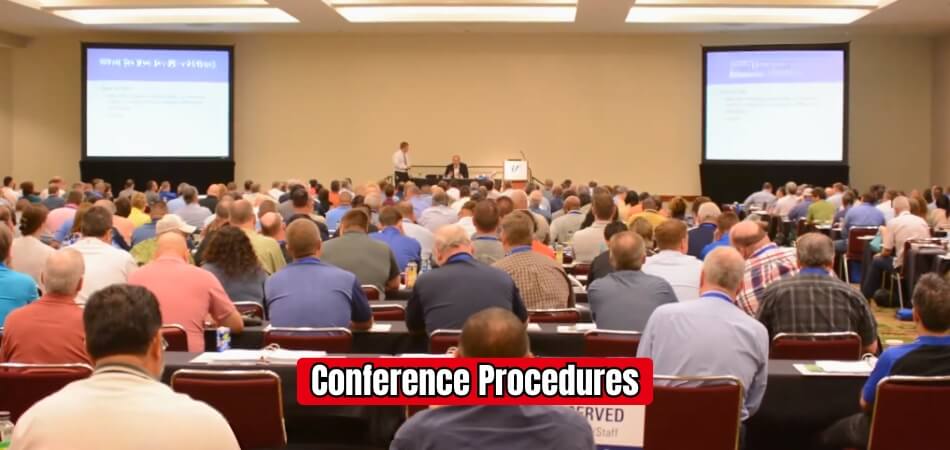Organizing a successful conference involves various elements, from planning the agenda to managing participant interactions. One crucial aspect is understanding the procedures that ensure everything runs smoothly. So, what is conference procedures?
Conference procedures involve the systematic handling of tasks during a conference, including allowing reports from Conference Committee Chairpersons to be voted on collectively. This streamlines decision-making and ensures efficient management of conference activities.
If you’re interested in learning more about the intricacies of conference procedures and how they can benefit your next event, read on for detailed insights and practical tips.
Core Purpose of a Conference?
The primary purpose of a conference is to bring together like-minded individuals to share knowledge, network, and collaborate. It provides a platform for professionals to discuss recent advancements and trends in their field. Such events help in developing innovation and community building among peers.

During a conference, attendees are encouraged to attend workshops, talks, and panel discussions. The experience can be boosted if participants know what successful conference features to look for before attending. Furthermore, these events provide a platform for academic and professional exchange, enriching everyone’s knowledge.
Also, conferences inspire attendees by exposing them to new ideas and methodologies. They offer a unique opportunity for personal and professional growth through direct interaction with experts. This exposure is vital for staying updated in fast-evolving industries and can propel one’s career forward.
What is Conference Procedures?
Conference procedures provide a roadmap for managing and running events smoothly. They ensure that all sessions progress in an orderly fashion, keeping everything on schedule. These methods also involve preparing, executing, and wrapping up various event segments efficiently. Knowing them helps organizers and attendees achieve the most from their participation.
To grasp conference procedures better, it’s helpful to explore the key elements involved. This approach not only improves the experience but also maximizes the benefits of attending or organizing a conference.
Elements of Conference Procedures:
Registration Process
The registration process is essential for collecting attendee information and ensuring smooth event entry. It involves setting up online registration forms and managing payment options. Proper registration helps organizers track attendance and plan accordingly. Timely communication with registrants is essential for confirming their participation.
Scheduling and Agenda Planning
Creating a well-structured schedule is key to conference success. The agenda should include all sessions, breaks, and networking opportunities. Organizers must consider timing to avoid overlapping events, ensuring attendees can participate fully. A clear agenda helps attendees get around the event easily.
Communication and Coordination
Effective communication between organizers, speakers, and participants is vital for a successful conference. The company will send timely updates, reminders, and important information before and during the event. Coordinating with speakers and vendors ensures everything runs smoothly. Good communication minimizes misunderstandings and improves the overall experience.
On-site Management
On-site management is about handling logistics during the conference, including registration desks, session setups, and attendee assistance. It requires coordination with venue staff and volunteers to manage the event effectively. Quick problem-solving skills are essential for addressing issues that arise. Good on-site management contributes to a positive attendee experience.
Post-Event Follow-Up
Following up after the conference is key for gathering feedback and improving future events. This includes sending out surveys, sharing presentations, and thanking participants. Post-event follow-up helps maintain relationships and build loyalty among attendees. It also provides valuable insights for future event planning.
Why Are Conference Procedures Important?
To collaborate, learn, and grow professionally, conferences are essential. Effective procedures are crucial for maintaining order and successful outcomes. All participants can benefit from understanding why conference procedures are important.
Ensuring Order and Structure
Conference procedures provide a structured framework for meetings. This structure helps manage time efficiently and keeps discussions on track. Participants understand the sequence of events and expectations. Orderly meetings lead to productive outcomes.
Promoting Fairness and Equality
Procedures ensure all voices are heard during discussions. Everyone gets an equal opportunity to contribute and share their viewpoints. This inclusivity promotes diverse perspectives and ideas. Fairness in proceedings encourages a positive environment.
Improving Transparency and Accountabilit
The clarity of procedures provides transparency by informing participants who make the decisions and how they are made. This clarity builds trust and helps attendees feel more confident about the steps to attending a conference. Additionally, documented processes ensure accountability and maintain trust and integrity throughout the event.
Facilitating Effective Decision-Making
Structured procedures simplify the decision-making process. Voting on issues is organized and efficient, avoiding confusion. Clear guidelines help in reaching consensus quickly. Effective decisions contribute to the success of the conference.
Supporting Common Conference Objectives
Procedures align with common conference objectives such as knowledge sharing and networking. They ensure these objectives are met systematically. Participants can focus on content rather than logistics. This alignment increases the overall conference experience.
Encouraging Active Participation
Well-defined procedures encourage active engagement from all attendees. Knowing the rules boosts confidence in participation. Engaged participants contribute to richer discussions and insights. Active involvement is key to a successful conference.
Adapting to Different Conference Types
Different conferences may require specific procedures fitted to their needs. Academic, corporate, and governmental conferences have unique requirements. It is crucial to understand these variations. Proper procedures ensure each type of conference runs smoothly.
Who Determines Conference Procedures?
When attending a conference, understanding who sets the procedures can make the experience smoother. Conference procedures guide the event’s flow, ensuring everything runs efficiently. Here’s explore who is responsible for these crucial guidelines.
Conference Committee’s Role
The conference committee determines the conference procedures and guides every aspect of event planning. This selected group handles everything from logistics to the overall structure, ensuring smooth execution. Their decisions directly impact all attendees’ experience and satisfaction. By recognizing the importance of conference committees, we can create successful and memorable events.
Influence of Organizational Bylaws
Many conferences adhere to organizational bylaws when setting procedures. These bylaws are pre-established rules that guide the organization’s operations. They ensure consistency and fairness in decision-making processes. Bylaws help maintain the integrity and standards of the event.
Parliamentary Rules Application
Parliamentary rules often influence conference procedures. These rules provide a formal framework for conducting meetings. They ensure orderly discussions and decision-making. Familiar parliamentary procedures include Robert’s Rules of Order.
Specific Conference Guidelines
Some conferences have unique guidelines specific to their needs. These guidelines are developed to address specific goals and challenges of the event. They can include detailed instructions on session formats, speaker protocols, and attendee conduct. Specialized guidelines help meet the conference’s unique objectives.
Role of Governing Bodies
Governing bodies play a significant role in determining procedures. These bodies are often composed of senior members of the organization. They provide oversight and approval of the organizing committee’s plans. Their experience and authority lend credibility to the conference structure.
Collaborative Decision-Making
Decision-making for conference procedures is often collaborative. Input is sought from various stakeholders, including committee members, governing bodies, and sometimes attendees. This collaborative approach ensures diverse perspectives are considered. It leads to more comprehensive and effective procedures.
Are There Variations in Conference Procedures Based on the Type of Conference?
Yes, conference procedures can vary significantly depending on the type of conference. Different types of conferences, such as academic, professional, or industry-specific events, have distinct goals, audiences, and formats. Procedures must be adapted to the needs and expectations of attendees.
Goals and Objectives
Conference goals heavily influence procedures. Academic conferences focus on sharing research and findings. Corporate events aim to showcase products, services, and innovations. Different goals require different sessions and activities to achieve specific outcomes.
Audience Composition
The audience affects conference procedures. Academic conferences attract scholars, researchers, and students. Professional conferences gather industry experts, practitioners, and business leaders. Each audience has unique expectations, shaping the format and content of the event.
Session Formats
Session formats differ based on conference type. Academic conferences feature presentations, panels, and poster sessions. Industry conferences include keynote speeches, workshops, and product demos. Each format is designed to suit the content and engage the audience effectively.
Networking Opportunities
Networking opportunities vary by conference type. Professional conferences prioritize networking sessions, allowing attendees to connect and collaborate. Academic conferences offer networking through breaks, social events, and discussions. Effective networking is adapted to the audience’s needs and interests.
Venue and Logistics
Venue and logistics play a role in shaping procedures. Large-scale conferences require extensive planning and coordination. Smaller conferences might have simpler logistics. The venue’s capabilities and size influence the event’s flow and structure.
Technology Integration
Technology integration is crucial in modern conferences. Virtual and hybrid conferences use technology for seamless experiences. Academic conferences might employ advanced tools for presentations and discussions. Industry conferences leverage technology for interactive sessions and product showcases.
FAQs for What is Conference Procedures?
Successful conferences require effective conference procedures. It is important to understand these procedures in order to ensure smooth operation and effective participation. Here are some frequently asked questions and their answers:
How Do Organizational Bylaws Affect Conference Procedures?
Organizational bylaws provide a framework for conference procedures. They ensure consistency and fairness in decision-making. Adhering to bylaws helps maintain the integrity and standards of the event, ensuring all actions align with organizational values.
What Role Do Parliamentary Rules Play in Conference Procedures?
Parliamentary rules offer a formal structure for conducting meetings. They help manage discussions and decision-making processes efficiently. Commonly used rules, like Robert’s Rules of Order, ensure orderly and productive meetings.
How Do Specific Conference Guidelines Influence Procedures?
Specific conference guidelines are developed to address the unique goals and challenges of an event. They include instructions on session formats, speaker protocols, and attendee conduct. Tailored guidelines ensure the conference meets its objectives effectively.
How Does Technology Integration Impact Conference Procedures?
Technology integration is crucial for modern conferences, especially virtual and hybrid events. It facilitates seamless experiences and increases engagement. Advanced tools are used for presentations, discussions, and interactive sessions, improving overall efficiency.
How Can Understanding Conference Procedures Benefit Participants?
Participants can drive the event more effectively if they understand conference procedures. It ensures they know what to expect, how to engage, and the structure of activities. This knowledge improves their overall conference experience and productivity.
Bottom Lines
Conference procedures are essential for anyone involved in organizing or attending these events. The goals and objectives of the conference, the audience composition, and the session formats play an important role in shaping these procedures. You can better prepare and engage in the conference by understanding these elements.
It is crucial to recognize the differences based on the type of conference when considering “What is conference procedures?”. Academic gatherings, conferences, and industry events all have unique requirements. Participants are provided with tailored networking opportunities, session formats, and technological integrations.
An effective conference procedure is crucial to a successful event. All attendees benefit from their structure, fairness, and facilitation of decision-making. Participants can maximize their learning, networking, and professional growth opportunities by understanding and adapting these procedures.






